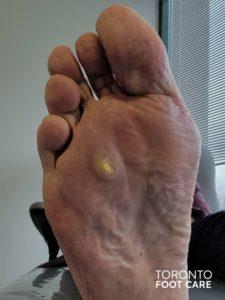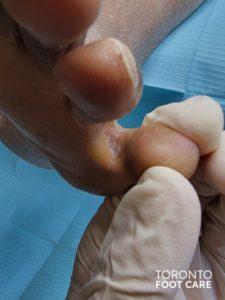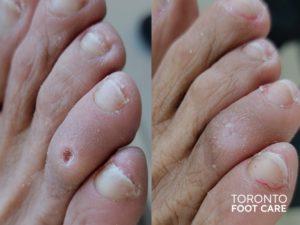Corns and Calluses
Corns and calluses are hard and thickened areas of the skin caused by repeated friction or pressure. The thickened skin is the body’s mechanism to help protect the underneath structures from further irritation.
Corns are localized, small, and rounded areas of thickened skin generally found on the top or between the toes and the bottom of the foot. Plantar/hard corns can be hard and dry with a hard central core or soft and moist in appearance. Soft corns can develop between any of the toes but most commonly between the fourth and fifth toes.
Calluses are thick and irregular patches of skin commonly found on the bottom of the foot at a site of repeated friction, irritation, and pressure. Unlike corns, calluses have undefined margins.

Interesting Fact: there is an increase chance of plantar callus formation with patients who smoke cigarettes (Merrill et al., 2012).
6 Common Symptoms for Corns and Calluses
- A thick, rough area of skin
- Hard skin with yellow appearance
- Flaky, dry, or waxy looking skin
- Pain and difficulty walking
- Feel like walking on a pebble or a rock
- May create pinpoint bleeding


Causes
Some calluses and corns are related to walking problems or foot abnormalities from increased stress on parts of the foot. Other possible contributing factors may include but are not limited to poor-fitting shoes, plugged sweat glands, increased blood supply, cigarette users, autoimmune disorders, and vitamin deficiencies.
Untreated corns and calluses can become painful as they can lead to pressure sores and may affect the rest of the body and other joints due to the compensation for the pain. Patients can become a higher risk when the pain becomes undetected due to peripheral neuropathy (i.e. diabetic neuropathy). It may become an ulcer which may lead to an infection.
Corns and Calluses Treatment Options
Many home remedies and over-the-counter (OTC) applications at local pharmacies and drug stores promote getting rid of corns and calluses but they are ineffective, especially for chronic conditions. Compared to the rest of our body, our feet have extra layers of skin which makes the calluses and corns thicker and more difficult to treat. It is ideal to seek help from a chiropodist or podiatrist.
At the Toronto Foot Care clinic, the chiropodist will offer different treatment options depending on the severity of the condition. In most cases, they will have to debride and scrap off the excess skin and assess if there is any underlying wart or a foreign body underneath the skin that has been hiding for many years. The chiropodist may also perform a thorough biomechanical assessment and footwear assessment and short-term treatments such as chairside padding and strapping to offload the pressure inside the shoes. Long-term treatment may require custom foot orthotics to correct the pressure distribution when walking or performing activities.
Although treating the symptoms is only one part of the solution, it is always important to find and treat the cause of the problem, otherwise, it will and may continue to come back.

Ready for your first visit?
Book an appointment today or call us at (416) 444-3668 to learn more about our foot care services.
Antończak P. P., Hartman-Petrycka M., Garncarczyk A., Adamczyk K., Wcisło-Dziadecka D., and Błońska-Fajfrowska B. (2023). The effect of callus and corns removal treatments on foot geometry parameters, foot pressure, and foot pain reduction in women. Applied Sciences. 2023; 13(7):4319.
Bristow, I. R., and Webb, C. J. (2020). Successful treatment of hard corns in two patients using microwave energy. Case Reports in Dermatology, 12(3), 213–218.
Freeman D. B. (2002). Corns and calluses resulting from mechanical hyperkeratosis. American Damily Physician, 65(11), 2277–2280.
Merrill, T. J., Vena, V., and Rodriguez L. A. (2012). Relationship between smoking and plantar callus formation of the foot. The Podiatry Institute. 38: 196-199.
